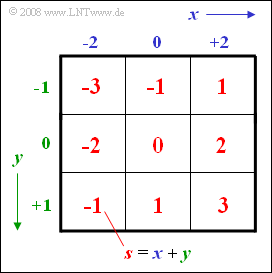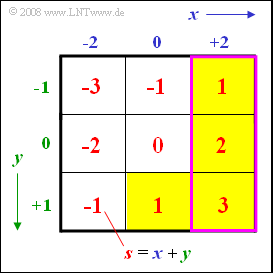Difference between revisions of "Aufgaben:Exercise 1.4Z: Sum of Ternary Quantities"
From LNTwww
| Line 1: | Line 1: | ||
| − | {{quiz-Header|Buchseite= | + | {{quiz-Header|Buchseite=Theory_of_Stochastic_Signals/Statistical_Dependence_and_Independence}} |
| − | [[File:P_ID79__Sto_Z_1_4.png|right|frame| | + | [[File:P_ID79__Sto_Z_1_4.png|right|frame|Sum of two ternary variables $x$ and $y$]] |
| − | + | Let be given the ternary random variables | |
:$$x ∈ {–2, \ 0, +2},$$ | :$$x ∈ {–2, \ 0, +2},$$ | ||
| Line 9: | Line 9: | ||
:$$y ∈ {–1, \ 0, +1}.$$ | :$$y ∈ {–1, \ 0, +1}.$$ | ||
| − | + | These two ternary values each occur with equal probability. From this, the sum $s = x + y$ is formed as a new random variable. | |
| − | + | The adjacent scheme shows that the sum $s$ can take all integer values between $–3$ and $+3$ : | |
:$$ s \in \{-3, -2, -1, \ 0, +1, +2, +3\}.$$ | :$$ s \in \{-3, -2, -1, \ 0, +1, +2, +3\}.$$ | ||
| Line 20: | Line 20: | ||
| − | + | Hints: | |
| − | + | *The exercise belongs to the chapter [[Theory_of_Stochastic_Signals/Statistical_Dependence_and_Independence|Statistical dependence and independence]]. | |
| − | * | ||
| − | * | + | *The topic of this chapter is illustrated with examples in the (German language) learning video |
| − | + | :[[Statistische_Abhängigkeit_und_Unabhängigkeit_(Lernvideo)|Statistische Abhängigkeit und Unabhängigkeit]] $\Rightarrow$ "Statistical dependence and independence". | |
| − | === | + | ===Questions=== |
<quiz display=simple> | <quiz display=simple> | ||
| − | { | + | {Calculate the probability that the sum $s$ is positive: |
|type="{}"} | |type="{}"} | ||
${\rm Pr}(s>0) \ = \ $ { 0.4444 3% } | ${\rm Pr}(s>0) \ = \ $ { 0.4444 3% } | ||
| − | { | + | {Calculate the probability that both the input $x$ and the sum $s$ are positive: |
|type="{}"} | |type="{}"} | ||
${\rm Pr}\big [(x>0) \cap (s>0)\big] \ = \ $ { 0.3333 3% } | ${\rm Pr}\big [(x>0) \cap (s>0)\big] \ = \ $ { 0.3333 3% } | ||
| − | { | + | {Calculate the conditional probability that the input variable $x > 0$ , when $s > 0$ holds: |
|type="{}"} | |type="{}"} | ||
${\rm Pr}(x>0\hspace{0.05cm}|\hspace{0.05cm}s>0)\ = \ $ { 0.75 3% } | ${\rm Pr}(x>0\hspace{0.05cm}|\hspace{0.05cm}s>0)\ = \ $ { 0.75 3% } | ||
| − | { | + | {Calculate the conditional probability that the sum $s$ is positive when the input variable is $x > 0$ : |
|type="{}"} | |type="{}"} | ||
${\rm Pr}(s>0\hspace{0.05cm}|\hspace{0.05cm}x>0)\ = \ $ { 1 } | ${\rm Pr}(s>0\hspace{0.05cm}|\hspace{0.05cm}x>0)\ = \ $ { 1 } | ||
| Line 50: | Line 49: | ||
</quiz> | </quiz> | ||
| − | === | + | ===Solution=== |
{{ML-Kopf}} | {{ML-Kopf}} | ||
| − | [[File:P_ID99__Sto_Z_1_4_a.png|right|frame| | + | [[File:P_ID99__Sto_Z_1_4_a.png|right|frame|Ternary variables in the Venn diagram]] |
| − | In | + | In the adjacent graph |
| − | * | + | *the three fields belonging to the event $„x > 0“$ are outlined in purple, |
| − | * | + | *the fields for $„s > 0“$ are highlighted in yellow. |
| − | + | All sought probabilities can be determined here with the help of the classical definition. | |
<br><br> | <br><br> | ||
| − | '''(1)''' | + | '''(1)''' This event is marked by the fields with yellow background: |
:$$\rm Pr (\it s > \rm 0) = \rm 4/9 \hspace{0.15cm}\underline { \approx \rm 0.444}.$$ | :$$\rm Pr (\it s > \rm 0) = \rm 4/9 \hspace{0.15cm}\underline { \approx \rm 0.444}.$$ | ||
| − | '''(2)''' | + | '''(2)''' The following facts hold here: |
:$$\rm Pr \big[(\it x > \rm 0) \cap (\it s>\rm 0) \big ] = \rm Pr(\it x > \rm 0) =\rm 3/9\hspace{0.15cm}\underline { \approx \rm 0.333}. $$ | :$$\rm Pr \big[(\it x > \rm 0) \cap (\it s>\rm 0) \big ] = \rm Pr(\it x > \rm 0) =\rm 3/9\hspace{0.15cm}\underline { \approx \rm 0.333}. $$ | ||
| − | '''(3)''' | + | '''(3)''' Using the results of subtasks '''(1)''' and '''(2)''' , it follows: |
:$$\rm Pr \big[(\it x > \rm 0) \hspace{0.05cm}| \hspace{0.05cm} (\it s > \rm 0)\big] = \frac{{\rm Pr} [(\it x > \rm 0) \cap (\it s > \rm 0)]}{{\rm Pr}(\it s > \rm 0)}= \frac{3/9}{4/9}\hspace{0.15cm}\underline {= 0.75}.$$ | :$$\rm Pr \big[(\it x > \rm 0) \hspace{0.05cm}| \hspace{0.05cm} (\it s > \rm 0)\big] = \frac{{\rm Pr} [(\it x > \rm 0) \cap (\it s > \rm 0)]}{{\rm Pr}(\it s > \rm 0)}= \frac{3/9}{4/9}\hspace{0.15cm}\underline {= 0.75}.$$ | ||
| − | '''(4)''' | + | '''(4)''' Analogous to subtask '''(3)''' now holds: |
:$$\rm Pr(\it s > \rm 0 \hspace{0.05cm} | \hspace{0.05cm} \it x > \rm 0)=\frac{Pr \big[(\it x > \rm 0) \cap (\it s > \rm 0) \big]}{Pr(\it x >\rm 0)}=\rm \frac{3/9}{3/9}\hspace{0.15cm}\underline {= 1}.$$ | :$$\rm Pr(\it s > \rm 0 \hspace{0.05cm} | \hspace{0.05cm} \it x > \rm 0)=\frac{Pr \big[(\it x > \rm 0) \cap (\it s > \rm 0) \big]}{Pr(\it x >\rm 0)}=\rm \frac{3/9}{3/9}\hspace{0.15cm}\underline {= 1}.$$ | ||
{{ML-Fuß}} | {{ML-Fuß}} | ||
Revision as of 22:42, 28 November 2021
Let be given the ternary random variables
- $$x ∈ {–2, \ 0, +2},$$
- $$y ∈ {–1, \ 0, +1}.$$
These two ternary values each occur with equal probability. From this, the sum $s = x + y$ is formed as a new random variable.
The adjacent scheme shows that the sum $s$ can take all integer values between $–3$ and $+3$ :
- $$ s \in \{-3, -2, -1, \ 0, +1, +2, +3\}.$$
Hints:
- The exercise belongs to the chapter Statistical dependence and independence.
- The topic of this chapter is illustrated with examples in the (German language) learning video
- Statistische Abhängigkeit und Unabhängigkeit $\Rightarrow$ "Statistical dependence and independence".
Questions
Solution
In the adjacent graph
- the three fields belonging to the event $„x > 0“$ are outlined in purple,
- the fields for $„s > 0“$ are highlighted in yellow.
All sought probabilities can be determined here with the help of the classical definition.
(1) This event is marked by the fields with yellow background:
- $$\rm Pr (\it s > \rm 0) = \rm 4/9 \hspace{0.15cm}\underline { \approx \rm 0.444}.$$
(2) The following facts hold here:
- $$\rm Pr \big[(\it x > \rm 0) \cap (\it s>\rm 0) \big ] = \rm Pr(\it x > \rm 0) =\rm 3/9\hspace{0.15cm}\underline { \approx \rm 0.333}. $$
(3) Using the results of subtasks (1) and (2) , it follows:
- $$\rm Pr \big[(\it x > \rm 0) \hspace{0.05cm}| \hspace{0.05cm} (\it s > \rm 0)\big] = \frac{{\rm Pr} [(\it x > \rm 0) \cap (\it s > \rm 0)]}{{\rm Pr}(\it s > \rm 0)}= \frac{3/9}{4/9}\hspace{0.15cm}\underline {= 0.75}.$$
(4) Analogous to subtask (3) now holds:
- $$\rm Pr(\it s > \rm 0 \hspace{0.05cm} | \hspace{0.05cm} \it x > \rm 0)=\frac{Pr \big[(\it x > \rm 0) \cap (\it s > \rm 0) \big]}{Pr(\it x >\rm 0)}=\rm \frac{3/9}{3/9}\hspace{0.15cm}\underline {= 1}.$$

